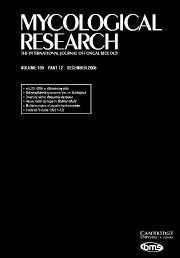Article contents
Ultrastructure of conidiogenesis and mature conidia in the plant pathogenic Entomosporium mespili
Published online by Cambridge University Press: 01 April 2000
Abstract
Acervuli of E. mespili developed subcuticularly on both surfaces of infected Photinia leaves. Acervuli developed as single or aggregated, confluent structures. Conidium initials arose from hyphae which developed between the cuticle and epidermis. As conidia developed the cuticle was displaced and eventually ruptured. Development of the first conidium from a conidiogenous cell was holoblastic. Subsequent conidia developed in an enteroblastic, annellidic fashion. Three to four conidia arose from a single conidiogenous cell. A mature conidium consisted of four to six cells including an apical cell and a basal cell which developed first. These were separated by a septum with a plugged pore. A similar septum separated the basal cell from the conidiogenous cell. A long, slender, enucleate appendage then arose from the tip of the apical cell. During this time the basal cell gave rise to two to four small lateral cells, separated by septa from the basal cell. An appendage then developed from each lateral cell. Each cell of a mature conidium contained a single nucleus and a complement of cytoplasmic organelles and inclusions, many of which were more prominent in freeze substituted conidia than in chemically fixed conidia. The conidium wall labelled for chitin using wheat germ agglutin-gold conjugate. Its outer surface was coated with fibrillar material.
- Type
- Research Article
- Information
- Copyright
- © The British Mycological Society 2000
- 6
- Cited by


